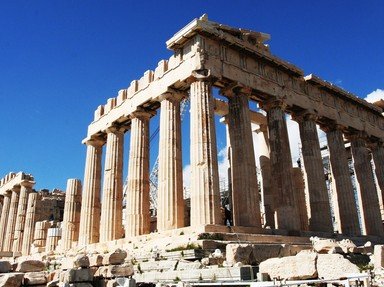Quiz Answer Key and Fun Facts
1. The city pictured might give you a clue. To which Greek goddess was the Parthenon dedicated?
2. The Parthenon was built after a tremendous victory from a series of wars that lasted from 499 BC- 449 BC. This Hellenic victory was over what historical empire, which is also known as the Achaemenid Empire?
3. Greek temples were places of worship, but due to their importance, they (including the Parthenon) also served as what other kind of building, such as this one located at the Temple of Apollo in Delphi?
4. Pictured here is an example of an architectural and artistic element that once graced the Parthenon, one of 92. What are these carved plaques called?
5. This 1868 painting includes them both. Which Greek leader ordered the construction of the Parthenon, and which Greek architect supervised both its construction and the creation of its sculptures found within?
6. The marble used to build the Parthenon was sourced from a quarry inside Greece.
7. This Roman-era statue, called the "Varvakeion Athena" is the most faithful reproduction of the monumental statue which stood in the inner chamber of the Parthenon. It is an example of chryselephantine sculpture. What elements are present in "chryselephantine" sculpture?
8. Pictured is an example of a pediment, this one on the Church of Sainte-Marie-Madeleine in Paris. Which of the following was featured on the pediments of the Parthenon?
9. Taken in 1896, this photograph is a good demonstration of just how long the Parthenon has been around. Which of these historical events related to the Parthenon NEVER happened?
10. Restoration efforts concerning the Parthenon and wider Acropolis have existed for decades. Which body, in cooperation with the Greek government, is at the forefront of these efforts?
Source: Author
trident
This quiz was reviewed by FunTrivia editor
stedman before going online.
Any errors found in FunTrivia content are routinely corrected through our feedback system.
